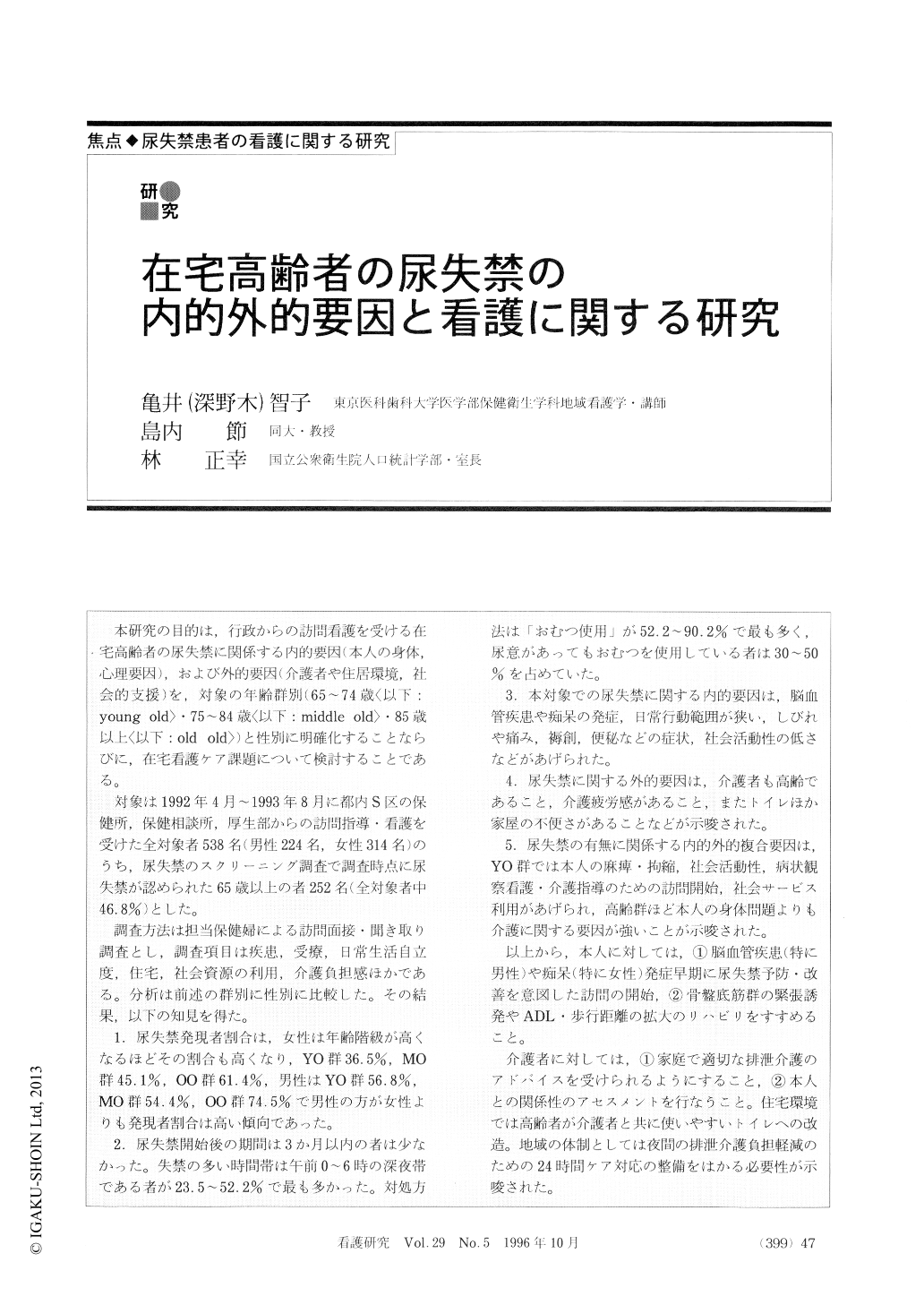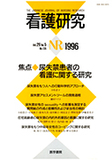Japanese
English
- 有料閲覧
- Abstract 文献概要
- 1ページ目 Look Inside
本研究の目的は,行政からの訪問看護を受ける在宅高齢者の尿失禁に関係する内的要因(本人の身体,心理要因),および外的要因(介護者や住居環境,社会的支援)を,対象の年齢群別(65〜74歳<以下:young old>・75〜84歳<以下:middle old>・85歳以上<以下:old old>)と性別に明確化することならびに,在宅看護ケア課題について検討することてある。
対象は1992年4月〜1993年8月に都内S区の保健所,保健相談所,厚生部からの訪問指導・看護を受けた全対象名538名(男性224名,女性314名)のうち,尿失禁のスクリーニング調査で調査時点に尿失禁が認められた65歳以上の者252名(全対象名中46.8%)とした。
The present study was made not only to clarify endogenous factors (physical and psychological factor of the subjects) and exogenous factors (caregiver residential environment, social assistance) in the urinary incontinence of elderly persons at home undergoing publie visiting nursing, both by sexes and by age-groups [65-74 years (young old), 75-84 years (middle old), more than 85 years (old old)], but also to examine nursing care problems at home.
The subjects were 252 elderly persons>65 years (46.8% of all subjects), who were detected for urinary incontinence by incontinence screening examination from among 538 subjects (224 males, 314 females), who underwent visiting nursing by Public Health Centers, and the health and welfare department of intra-metropolitan S Ward from April 1992 to August 1994.
The screening examination was made via visiting interview and hearing by Public Health Nurses in charge, about items for examination such as disease, treatment, degree of independency for ADL, residence, utilization of social resources, nursing burden sensation, etc. The analysis was made comparatively by age-groups and by sexes, as mentioned above. The following information was obtained;
1) In terms of the incidence of urinary incontinence, female subjects showed higher incidence for higher age-grade (36.5%, for YO group, 45.1% for MO group and 61.4% for OO group), and male subjects showed higher incidence than female subjects (56.8% for YO group, 54.4% for MO group and 74.5% for OO group).
2) A few subjects were found within 3 months of the onset of urinary incontinence. Incontinence-favorite time zone was predominantly the midnight zone of 0-6 o'clock a.m. (23.5-52.2%). Care approach by caregiver was predominantly “use of diaper” (52.2-90.2%) and “use of diaper even with micturition” represented 30-50%.
3) Endogenous factors involved onset of cerebrovascular disease or dementia, narrrow range of ADL, symptoms such as numbness and pain, bedsore, constipation, low social activity, etc.
4) Exogenous factors involved elderly caregiver persons, residual care fatigue sensation, inconvenient toilet and other housing condition, etc.
5) Endogenous-exogenous compound factors in possible urinary incontinence involved paralysis, contrature, social activity, start of visiting for morbid state observational nursing, guidance and utilization of social services for YO group, suggesting strong factor involving the care rather than physical problems of the subject concerned for elder group.
From the above, suggestions for the subject concerned were made as follows; 1) start of visiting aiming at the prevention and improvement of urinary incontinence in early stage of onset of cerebrovascular disease (especially for males) or dimentia (especially for females) and 2) promotion of rehabilitation for tension provocation of pelvic muscular group and enlargement of ADL and walking distance, and suggestions for caregiver were made as follows; 1) giving appropriate advices for excretory nursing at home and 2) assessment of the relationship with the subject concerned. From the viewpoint of housing environment, reconstruction of such a toilet as is easily usable by both an elderly person and its nursing person and from the viewpoint of regional system, necessary preparation of 24-hour approach to diminution of nocturnal excretory nursing burden was suggested.

Copyright © 1996, Igaku-Shoin Ltd. All rights reserved.


